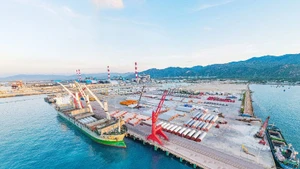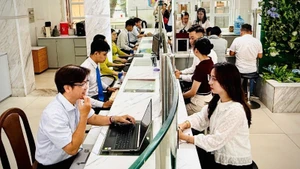Spanning 45,332 hectares, Dung Quat EZ is a comprehensive and multi-sector industrial zone. Its core industries include petrochemical refining, energy, mechanical engineering, metallurgy, and logistics. Leveraging Dung Quat’s deep-water port and Chu Lai Airport, the zone serves as a key international transportation and trade gateway for Vietnam’s central and Central Highlands regions.
Challenges revealed
Over 28 years, Dung Quat EZ has attracted 349 active projects with a total registered capital of 18.4 billion USD, including 65 foreign direct investment (FDI) projects valued at 2.3 billion USD. Of this, 12 billion USD has been realised. Currently, 261 projects are operational, contributing 1 billion USD annually to the province’s budget, accounting for 80% of Quang Ngai’s total revenue and creating jobs for approximately 73,900 workers.
However, Deputy Head of the Dung Quat EZ Management Board, Dam Minh Le, acknowledged issues with the traditional industrial park model. These include incomplete infrastructure planning, particularly centralised wastewater treatment systems, and a lack of interconnectivity among businesses for value chain production.
Many enterprises rely on energy-intensive and resource-heavy production, often exporting raw materials with low technological and value-added content. This approach limits competitiveness and overlooks the potential for circular economy practices, such as recycling production byproducts.
The establishment of VSIP Quang Ngai in 2012 introduced a modern, environmentally friendly industrial model with synchronised infrastructure, including wastewater treatment plants, fire stations, and amenities. VSIP’s design attracts investors in high-value, advanced technology industries while fostering a greener and more sustainable industrial ecosystem.
Industrial restructuring for green growth
Quang Ngai Province has devised a strategy to transition towards green industrial development. The focus is on creating industrial-urban-service parks, supporting industries, ecological industrial zones, and high-tech industrial zones to optimise land use and resources. The ultimate goal is to make Dung Quat EZ a green, specialised, and smart economic zone.
The province plans to restructure industries towards high-tech and green manufacturing to deepen integration into global supply chains. While continuing to capitalise on existing strengths in oil refining, petrochemicals, metallurgy, and mechanical engineering, these industries will be developed with an environmentally friendly and value-added approach.
Investments in renewable energy projects such as wind power and green hydrogen production are also prioritised to gradually reduce reliance on fossil fuels. By promoting green industries and services, Dung Quat aims to become a key logistics and trade hub in Vietnam’s central economic region. Additionally, the province envisions developing coastal and island eco-tourism zones, luxury resorts, and high-end entertainment facilities, enhancing Dung Quat’s appeal as a tourism and logistics centre.
To promote green growth, the Dung Quat EZ and Quang Ngai Industrial Parks Management Board have introduced six key solutions. First, they are planning industrial, urban, and service zones with balanced land use for green spaces, ecological buffers, and natural ecosystem conservation to ensure sustainable development.
Second, the focus is on attracting high-tech, high-value, and environmentally friendly manufacturing projects, transitioning from quantity-based to quality-driven industrial growth.
Third, they aim to develop eco-industrial parks and high-tech zones by encouraging investments in smart factories, renewable energy use (like green hydrogen), and advanced wastewater treatment systems to minimise environmental impact.
Fourth, policies will incentivise energy efficiency, industrial symbiosis, and circular economic practices by optimising resource use and embracing digital transformation.
Fifth, they are enhancing environmental management by building a database to monitor emissions and expediting wastewater treatment system construction while preserving green areas for sustainability.
Lastly, they are promoting industrial tourism by integrating cultural, ecological, and factory tours to showcase advanced production processes. This initiative not only attracts visitors but also fosters greater environmental responsibility among businesses. These efforts collectively aim to establish Dung Quat as a green, sustainable, and innovative economic zone, contributing to long-term development and global competitiveness.
















